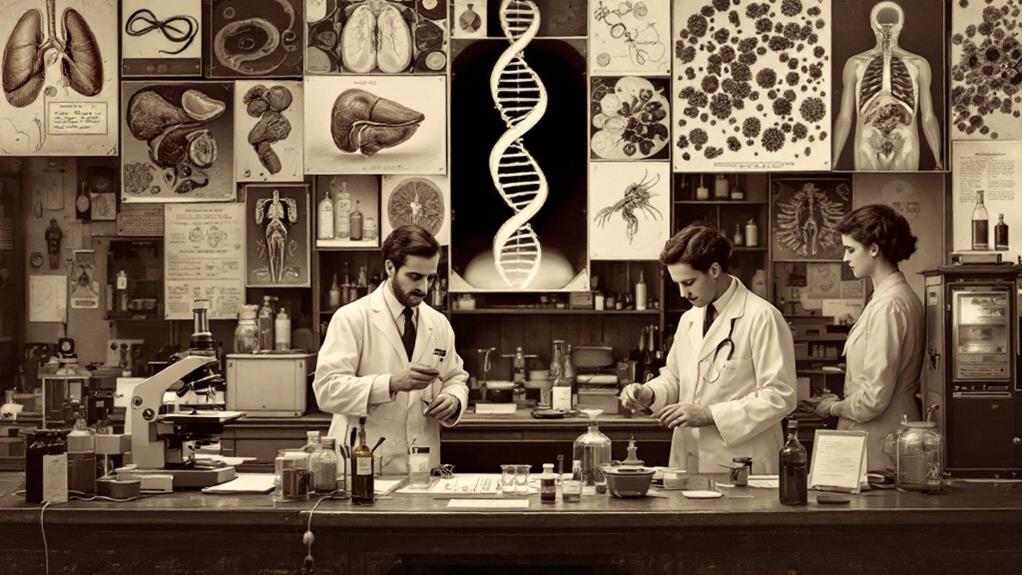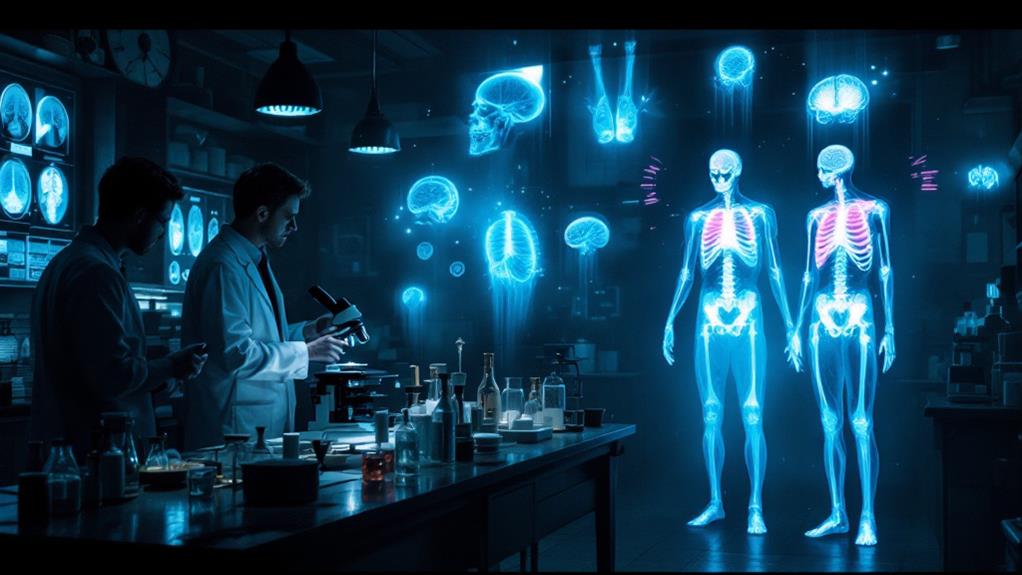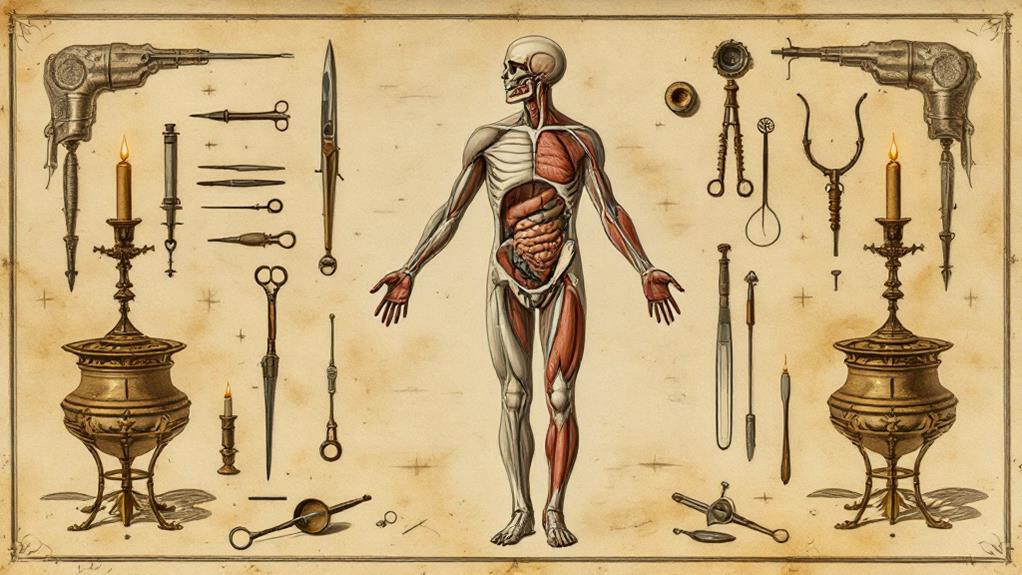The History of Medical and Health Sciences: Milestones in Healthcare

Throughout history, you've witnessed extraordinary advancements in medical and health sciences that have metamorphosed healthcare and improved the human condition. From ancient healing practices to the Hippocratic Oath, each milestone has shaped the field. The germ theory of disease revolutionized our understanding of illness, while anesthesia and surgical advancements made complex procedures possible. X-rays and medical imaging have enhanced diagnostics, and genetic medicine has opened new frontiers. Organ transplantation, vaccines, and precision medicine continue to save lives and improve global health. These milestones represent just a fraction of the incredible expedition medicine has taken. Exploring further will reveal even more captivating developments in healthcare's rich history.
Ancient Healing Practices
Four ancient civilizations laid the groundwork for modern medicine: Egypt, Greece, China, and India. These early societies developed sophisticated healing practices that combined empirical observations with spiritual beliefs.
In ancient Egypt, you'd find physicians using a mix of practical treatments and magical incantations. They were skilled in setting broken bones and treating wounds, while also relying on amulets and spells for protection against diseases. Greek medicine, epitomized by Hippocrates, introduced a more rational approach, emphasizing the importance of diet, exercise, and environmental factors in maintaining health.
Chinese traditional medicine, still practiced today, focused on balancing the body's essential energy or "qi." You'd encounter techniques like acupuncture and moxibustion, alongside traditional herbal remedies. In India, Ayurvedic medicine emerged, emphasizing the interconnectedness of mind, body, and spirit.
These ancient healing systems often incorporated spiritual healing practices, believing that physical ailments were linked to spiritual imbalances. While some of these early practices may seem primitive by today's standards, they laid the foundation for our modern understanding of health and disease, and many of their principles continue to influence alternative medicine approaches.
The Hippocratic Oath
The Hippocratic Oath stands as one of the oldest binding documents in history, originating in ancient Greece around the 5th century BCE. You'll find that this solemn pledge, attributed to Hippocrates, the "Father of Medicine," has shaped medical ethics for centuries. It's a commitment to uphold specific ethical standards in the practice of medicine.
Throughout history, the Oath's interpretation has evolved. Initially, it prohibited physicians from performing surgery, euthanasia, and abortion. Today's version focuses more on patient confidentiality, respect for teachers, and the obligation to share medical knowledge. You'll notice that modern Hippocratic ethics emphasize beneficence, non-maleficence, justice, and respect for patient autonomy.
While not legally binding, the Oath serves as a moral compass for medical professionals. It reminds you of the sacred trust between doctor and patient, emphasizing the importance of maintaining professional integrity. As you delve into medical history, you'll see how the Hippocratic Oath has adapted to reflect changing societal values while preserving its core principle: primum non nocere - first, do no harm.
Germ Theory of Disease

Moving from ancient ethical principles to revolutionary scientific revelations, we encounter the Germ Theory of Disease. This groundbreaking concept, developed in the 19th century, forever changed our understanding of illness and revolutionized healthcare practices.
You'll find that the Germ Theory attributes diseases to specific microorganisms, rather than miasma or imbalanced humors. Louis Pasteur, Robert Koch, and Joseph Lister were key figures in establishing this theory. Their work led to crucial advancements in identifying pathogens, understanding disease transmission mechanisms, and developing preventive measures.
The theory's impact on medicine can't be overstated. It paved the way for modern hygiene practices, sterilization techniques, and the development of vaccines and antibiotics. You've likely benefited from these innovations in your own healthcare experiences.
Today, the Germ Theory continues to evolve. Recent microbiome research has revealed the complex relationships between microorganisms and human health, expanding our understanding beyond simple pathogen-host interactions. This ongoing exploration promises to uncover new perspectives into disease prevention and treatment, further transforming the landscape of medical science.
Anesthesia and Surgical Advancements
Pioneering advancements in anesthesia and surgical methods have altered the medical environment since the mid-19th century. You'll find that the introduction of anesthesia in 1846 by William T.G. Morton revolutionized surgery, allowing for longer, more complex procedures without patient suffering. This breakthrough paved the way for rapid progress in surgical techniques and pain management.
As you investigate the history of surgical advancements, you'll uncover how antiseptic practices, introduced by Joseph Lister in the 1860s, dramatically reduced post-operative infections. These methods, combined with improved anesthesia, led to significant surgical risk reduction. You'll note that the development of local and regional anesthetics in the early 20th century further expanded surgical possibilities.
Throughout the 20th century, you'll see how anesthesia and surgical techniques continued to evolve. The introduction of muscle relaxants, intravenous anesthetics, and sophisticated monitoring equipment enhanced patient safety. Modern pain management techniques now include epidurals, nerve blocks, and patient-controlled analgesia. Today, you'll find that minimally invasive procedures and robotic-assisted surgeries represent the cutting edge of surgical advancements, further reducing risks and improving patient outcomes.
X-rays and Medical Imaging
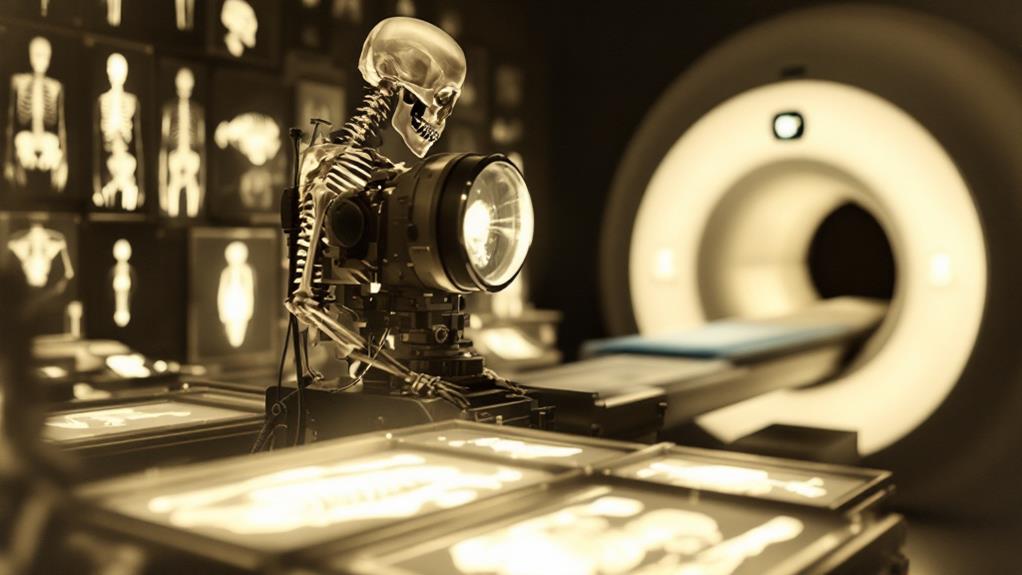
Uncovering the inner workings of the human body without invasive procedures became possible with the advent of X-rays in 1895. Wilhelm Roentgen's novel discovery revolutionized medical diagnosis, allowing doctors to see bones and detect abnormalities without surgery. This breakthrough paved the way for numerous diagnostic imaging advancements that have transformed healthcare.
As radiology techniques evolved, you've seen the emergence of various imaging modalities. Computed tomography (CT) scans, introduced in the 1970s, provide detailed cross-sectional images of organs and tissues. Magnetic resonance imaging (MRI), developed in the 1980s, uses powerful magnets to create high-resolution images without radiation exposure. Ultrasound technology, which uses sound waves to visualize internal structures, has become crucial in obstetrics and cardiology. Nuclear medicine imaging, such as PET scans, allows doctors to observe metabolic processes and detect diseases at a cellular level. These advancements have significantly improved diagnostic accuracy, enabling earlier detection of diseases and more precise treatment planning. Today, medical imaging continues to evolve with the integration of artificial intelligence, enhancing image quality and interpretation, and pushing the boundaries of what's possible in non-invasive diagnostics.
Antibiotics and Infectious Disease Control
While medical imaging revolutionized diagnostics, the uncovering of antibiotics altered treatment. You'll find that the revelation of penicillin by Alexander Fleming in 1928 marked a turning point in infectious disease control. This breakthrough allowed doctors to combat previously lethal bacterial infections effectively.
As antibiotics became widely available in the mid-20th century, you'd see a dramatic decrease in mortality rates from infections. Diseases like pneumonia, tuberculosis, and strep throat were no longer death sentences. However, with this success came a new challenge: antibiotic resistance. Bacteria evolved to withstand these powerful drugs, leading to the emergence of "superbugs."
Today, you're witnessing a global effort to combat antibiotic resistance through antimicrobial stewardship programs. These initiatives promote the judicious use of antibiotics to preserve their effectiveness. You'll find that healthcare professionals are now focusing on targeted treatments, shorter courses, and alternative therapies when possible. The future of infectious disease control lies in developing new antibiotics, improving diagnostic techniques, and educating both medical practitioners and the public about responsible antibiotic use.
DNA Structure and Genetic Medicine
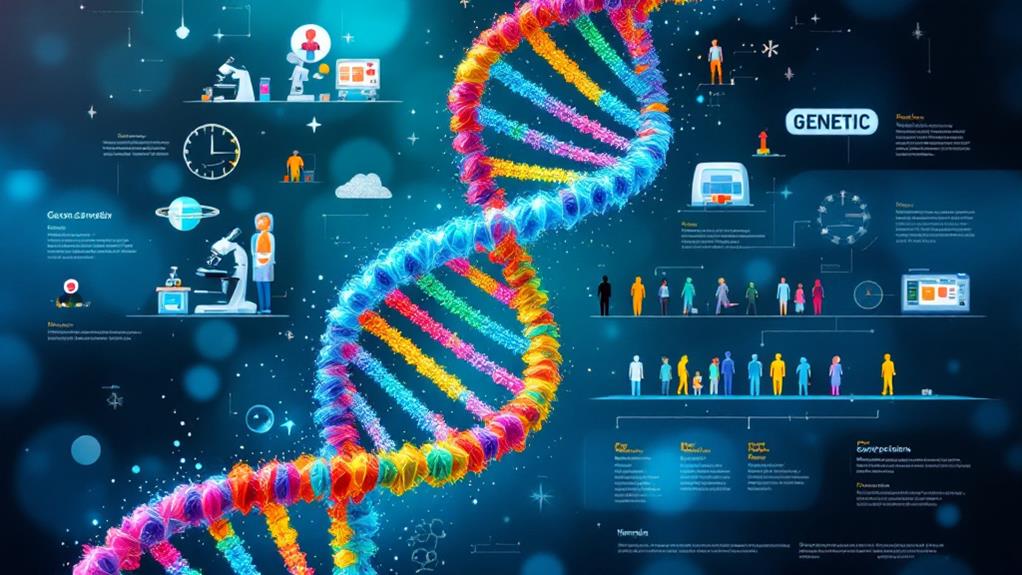
The revelation of DNA's double helix structure in 1953 by James Watson and Francis Crick marked a pivotal moment in medical history. This finding paved the way for genetic medicine, allowing scientists to understand how genes influence health and disease. You'll find that since then, genetic research has advanced rapidly, leading to breakthroughs in diagnosis, treatment, and prevention of genetic disorders.
Genome sequencing has revolutionized personalized medicine, enabling doctors to tailor treatments based on an individual's genetic makeup. You can now undergo genetic testing to assess your risk for certain diseases or determine the most effective medications for your body. Researchers have also uncovered the importance of epigenetic modifications, which affect gene expression without altering the DNA sequence.
The field of genetic medicine continues to evolve, offering new possibilities for:
- Gene therapy to treat inherited disorders
- CRISPR gene editing technology
- Pharmacogenomics for drug development
- Prenatal genetic screening
- Precision oncology for cancer treatment
As you delve into the world of genetic medicine, you'll uncover its potential to transform healthcare and improve lives on a global scale.
Organ Transplantation
Organ transplantation stands as one of the most extraordinary achievements in medical history. This groundbreaking procedure has saved countless lives and revolutionized the treatment of organ failure. The expedition began in the early 20th century with experimental animal transplants, paving the way for human trials.
The first successful human organ transplant occurred in 1954 when Dr. Joseph Murray performed a kidney transplant between identical twins. This milestone sparked a surge in research and development in the field. However, rejection remained a significant obstacle until the advent of immunosuppressive therapy in the 1960s.
As biomedical engineering advanced, surgeons tackled increasingly complex transplants. Heart transplants became a reality in 1967, followed by liver, pancreas, and lung transplants in subsequent years. The introduction of cyclosporine in the 1980s dramatically improved survival rates by preventing rejection more effectively.
Today, organ transplantation continues to evolve with innovations like xenotransplantation and 3D-printed organs. These advancements offer hope to patients on long waiting lists and push the boundaries of what's possible in medical science. Despite ongoing challenges, organ transplantation remains a testament to human ingenuity and the relentless pursuit of saving lives.
Vaccines and Global Health
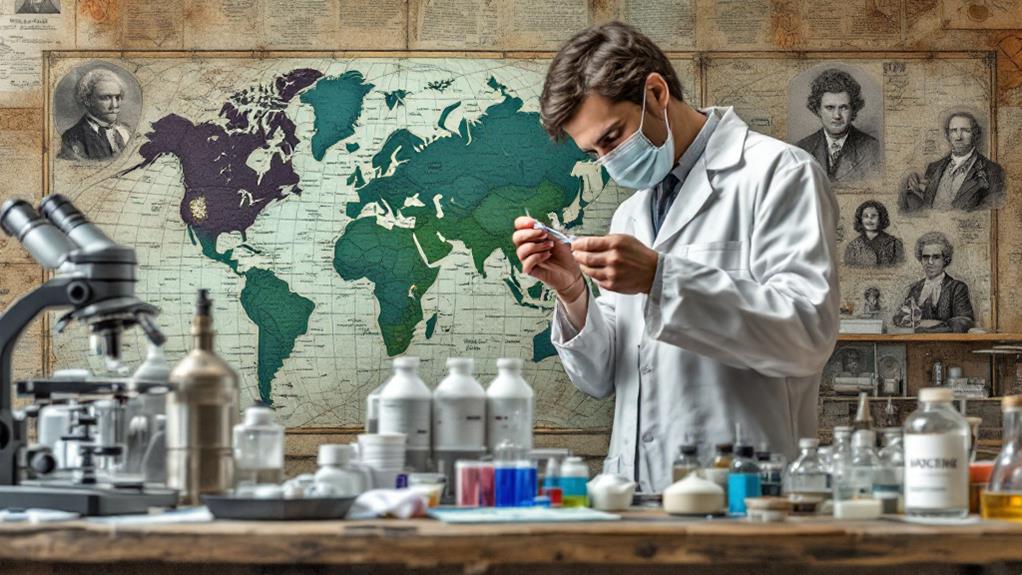
Vaccines have revolutionized global health in a way that rivals organ transplantation's impact on individual patients. You've likely benefited from this medical marvel, which has saved countless lives and drastically reduced the prevalence of deadly diseases worldwide.
The development of vaccines has led to extraordinary achievements in global disease eradication. You'll be amazed to know that smallpox, once a devastating illness, was declared eradicated in 1980 thanks to widespread vaccination efforts. Polio is on the brink of elimination, with only a few countries still reporting cases.
Vaccine distribution has become a vital aspect of global health initiatives. You'll find that organizations like the World Health Organization and UNICEF work tirelessly to guarantee vaccines reach even the most remote areas. Here are some key challenges in global vaccine distribution:
- Maintaining cold chain logistics
- Overcoming cultural barriers and vaccine hesitancy
- Securing funding for vaccine programs
- Addressing inequalities in access between rich and poor countries
- Developing new vaccines for emerging diseases
As you can see, vaccines continue to play a pivotal role in shaping the future of global health, preventing millions of deaths and improving quality of life worldwide.
Precision Medicine and Personalized Healthcare
Advances in genomics and data analytics have ushered in the era of precision medicine and personalized healthcare. You're now living in a time where your unique genetic makeup can guide your medical treatment. Doctors can customize therapies to your specific genetic profile, increasing effectiveness and reducing side effects.
The creation of vast genomic databases has revolutionized our understanding of disease risk and treatment responses. You can now access information about your genetic predispositions, allowing for proactive health management. This knowledge empowers you to make informed lifestyle choices and undergo targeted screenings.
Real-time health monitoring has become a reality through wearable devices and smartphone apps. You can track various health metrics, from heart rate to sleep patterns, providing relevant data to your healthcare providers. This continuous stream of information allows for early detection of potential health issues and more precise interventions.
Precision medicine isn't just about genetics; it considers your environment, lifestyle, and even your microbiome. By integrating all these factors, healthcare professionals can develop highly personalized treatment plans. You're no longer receiving one-size-fits-all care, but rather a customized approach that optimizes your health outcomes.
